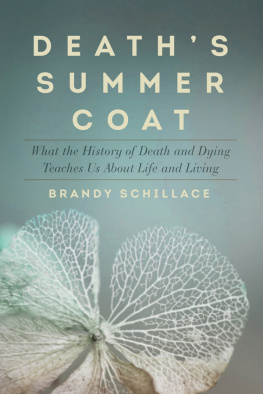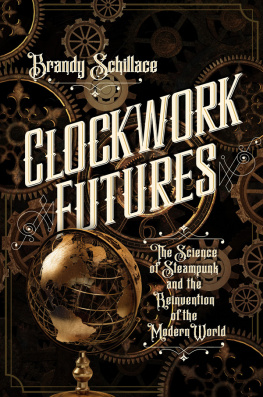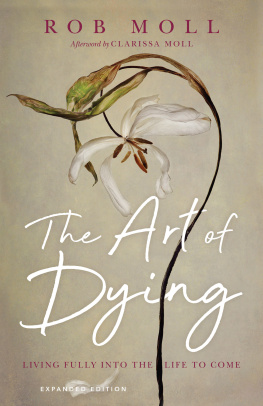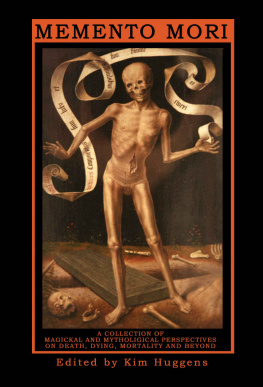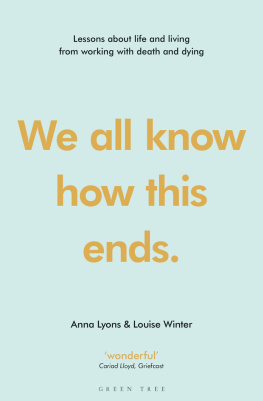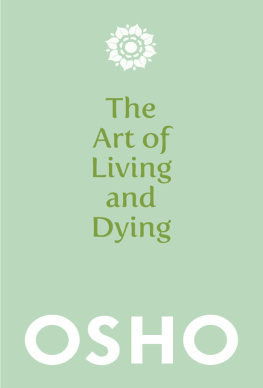
DEATHS SUMMER COAT

What the History of Death and Dying
Can Tell Us about Life and Living
BRANDY SCHILLACE

CONTENTS


Why a book like this one, and why now?
T he theatre was box-like, crouched behind razor wire off the strip in Los Angeles. Unremarkable, really; a dustcoloured square barely discernible from the others that dotted Beverly Boulevard under a hot October sun. You werent going to miss it, though. There were too many people out front, and nearly everyone whether in evening attire or metal studs wore black. A funeral? No, though the Grim Reaper was in attendance (with an actual scythe). A concert? An art show? Not quite. Here, not far from Hollywood, were gathered scholars, morticians, curators and an interested public for the first death cabaret part of the first ever Death Salon. The talks and events showcased something most people rarely, if ever, consider: our own mortality.
We die. We know this, in principle, and yet in the Western world we dont live with the idea of death. We refrain from thinking about it, we avoid reflecting upon it, and death is something most of us simply dont talk about. Death Salon is an unusual organisation in that it chooses death as a focus for discussion, but its part of an emerging death-positive movement, one that includes death cafes and death dinners. These gatherings call for the breaking of taboos, a desire to reclaim ground that has been lost particularly in the West during a century and a half of sanitisation and silence. Insulated by their relative wealth, health systems and the successes of hygiene and sterilisation, post-industrial nations have the privilege of a protective screen from unmediated images of death. Even so, these advances cannot ultimately protect us from death itself. Its time to rejoin the conversation.
Jon Underwood, a former British council worker, founded Death Cafe in 2011, inspired by the ideas of Bernard Crettaz, a Swiss sociologist who began a decade ago to encourage people to talk freely about death. Tea, cake and death are the order of the day, and many new death cafes (not run by Underwood) have sprouted up here and there as places to speak about the inevitable. These mortality meetings tend to create a stir, showing up in blog feeds, on Twitter and Facebook, and in news sites such as the Huffington Post and the New York Times . Even more recently, Kate Granger, a thirty-one-year-old British physician with terminal cancer, has committed to live-tweeting her final moments, and comedian Laurie Kilmartin (a writer for the Conan OBrien show) live-tweeted her fathers last days in hospice care. But these attempts at making death part of the conversation are not without their problems and detractors. Some commentators question whether making public these personal events is an appropriate use of social media, while others worry that these are novelty encounters which will ultimately lead to a clichd sense of death rather than true engagement with it. Regardless of what side you take, these platforms suggest an increasing number of us want to explore death or, at the very least, to broach the subject.
Why, someone asked recently, are events like Death Salon happening in Europe and the US? Why not elsewhere? To begin with, they are happening elsewhere; death cafes have been held in Hong Kong and in India. In an article entitled Care to Talk About Death Over Coffee? the Times of India asked people what they thought of the concept. One respondent, Soma Mukherjee, replied: I dont know if it will really work here [because] death is discussed from the time the first pet or grand-uncle dies. In cultures where death already has a place, where it already appears as a normal and approachable subject, there need be no taboo-breaking. Its only where we have lost the ability to discuss these subjects openly that we need new perspective.
Of course, in some ways, we are talking. The overwhelming popularity of Mary Roachs humorous look at what happens after death, Stiff: The Curious Lives of Human Cadavers , is a good example. Roach proves that we can learn a lot by studying the hidden, or at least less familiar, practices of the body after death from bodysnatching to medical cannibalism. The dead body, the cadaver, may reveal a lot about anatomy and the functions of the body. The history of those bodies can tell us a great deal about how perspectives have changed. But death in the abstract is a very different thing from death closer to home; it touches our families, our homes, our hearts. Death is a balancing act: we know it will happen to us, to those we love, and yet we live in denial. That denial often leaves us entirely unprepared for the other element of death: grief.
Most of us remember the sex talk. I got mine early, after catching the neighbours at it. I was five, and met my mother at the door when she got home, demanding to know how it was done. (I was horrified by the explanation, as most of us probably were.) It has long served as a kind of cultural touchstone in Western society: frequently referred to as the birds and the bees or, more ominously, the talk. But how many of us recall any similar kind of conversation on the subject of death? Or grief? Hospice care provides one means of readying the dying and their families, but more often the mortally sick go to a hospital, where they remain until death. Their bodies are transported from that sterile room to a funeral home, where they are prepared without our knowledge and often without our input. Its little wonder that discussion of death is taboo. My best friends mother, a breast cancer patient, tried repeatedly to talk about the looming possibility of her own death, only to be told that she should not speak of it. It is a strange irony: the last thing we are supposed (or allowed) to do when preparing to meet death is talk about death. Can you imagine the inverse? We would not plan for the birth of a child without addressing the subject of labour. Major events demand adequate preparation more than that, they require solemnity, significance. These make up our cultural rituals, and rituals have enormous power.
We find ourselves today in a culture of opposites: bent on living forever, but committed to the disposable nature of absolutely everything else. Looking to find meaning isnt an arbitrary quest: it is the human condition, and rituals are human events that help us find that meaning. While the word itself suggests imagery from religious practice, ritual really refers to behaviour actions performed with intention and significance. They may be as simple as a handshake or as complex as a rite of passage, but they stand for so much more. Rituals are the fabric of our cultural identities and they enable us to proceed through lifes great moments.
Has something happened to our rituals for death? For dying and for grieving? The silence that currently surrounds mortality is actually comparatively recent. In the death announcements of eighteenth-century Britain and the US, people did not pass on; they died. Euphemisms were used, too, but not often. Someone might, on occasion, kick the bucket (an expression that probably refers to the process of slaughtering hogs) and in the case of hanged criminals, they might swing home. But the real push towards euphemisms for death happened later, mainly in the mid to late nineteenth century. This shift can be seen even in the American funeral announcements shown here, which changed the wording in death notices from moulders here to slumbers here in the space of a decade. References to decay are removed for the more esoteric image of sleep; but why? What changed in Western culture? Fast-forward to the twenty-first century, and our language is even less able to confront the reality of death. We avoid using the word itself, talk in metaphors about brave battles and shy away from anything that might remind us of our own mortality. What drove us to sanitise death, and in so doing, make it foreign and unfamiliar?
Next page
